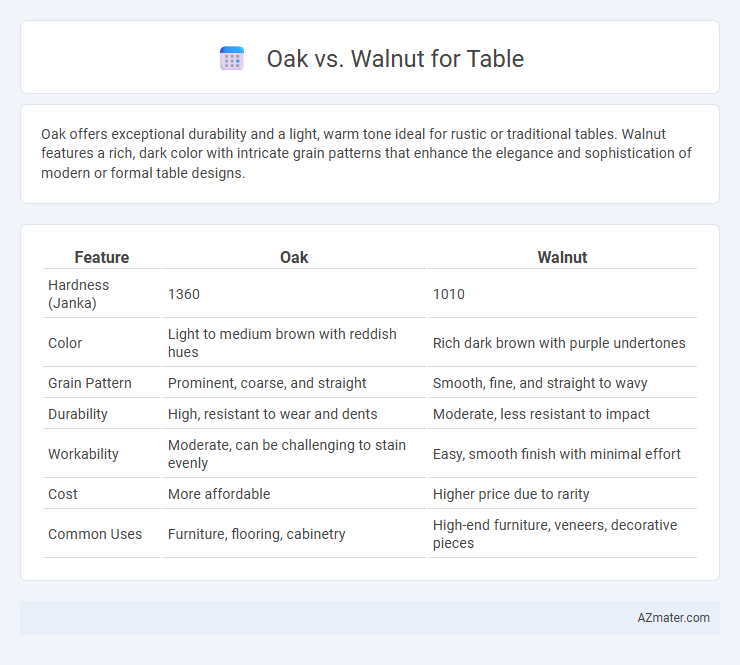Oak offers exceptional durability and a light, warm tone ideal for rustic or traditional tables. Walnut features a rich, dark color with intricate grain patterns that enhance the elegance and sophistication of modern or formal table designs.
Table of Comparison
| Feature | Oak | Walnut |
|---|---|---|
| Hardness (Janka) | 1360 | 1010 |
| Color | Light to medium brown with reddish hues | Rich dark brown with purple undertones |
| Grain Pattern | Prominent, coarse, and straight | Smooth, fine, and straight to wavy |
| Durability | High, resistant to wear and dents | Moderate, less resistant to impact |
| Workability | Moderate, can be challenging to stain evenly | Easy, smooth finish with minimal effort |
| Cost | More affordable | Higher price due to rarity |
| Common Uses | Furniture, flooring, cabinetry | High-end furniture, veneers, decorative pieces |
Introduction: Comparing Oak and Walnut for Tables
Oak and walnut are popular hardwood choices for tables, valued for their durability and aesthetic appeal. Oak features a pronounced grain and light to medium brown hues, offering a timeless and sturdy surface ideal for everyday use. Walnut presents a rich, dark brown color with a smooth, fine grain, making it a favored option for elegant and sophisticated table designs.
Appearance and Grain Patterns
Oak tables feature a prominent grain pattern with distinct rays and flecks that add texture and character to furniture, presenting a classic, rustic charm with light to medium brown tones. Walnut tables offer a smoother, more refined grain with subtle swirls and darker hues ranging from rich chocolate brown to purplish-black, enhancing elegance and warmth in interior spaces. The visual contrast between oak's bold, coarse grain and walnut's fine, uniform pattern influences the table's overall aesthetic and suitability for different design styles.
Color Variations: Oak vs Walnut
Oak features a wide range of color variations from light beige to medium brown with subtle yellow or reddish hues, offering a bright and warm aesthetic for tables. Walnut wood exhibits deeper, richer tones, ranging from creamy white sapwood to dark chocolate brown heartwood, often with striking purplish or gray undertones that provide a sophisticated and elegant look. The color stability and contrast between sapwood and heartwood in walnut create a more dramatic visual effect compared to oak's generally more uniform palette.
Durability and Hardness
Oak offers superior durability and hardness compared to most walnut varieties, exhibiting a Janka hardness rating of about 1,290 pounds, making it highly resistant to dents and wear. Walnut, with a Janka hardness around 1,010 pounds, is softer but still provides notable strength and durability suitable for furniture. Oak's tight grain structure enhances its toughness and resilience, while walnut's slightly softer texture allows for easier workability and a smoother finish.
Workability and Craftsmanship
Oak offers excellent workability with its coarse grain providing good stability and ease of shaping, making it a favorite for intricate craftsmanship in tables. Walnut, prized for its fine, consistent grain and natural smoothness, allows detailed carving and finishing, resulting in elegant, high-quality furniture pieces. Both woods respond well to hand and machine tools, but walnut's buttery texture often yields a superior finish in artisan table making.
Maintenance and Longevity
Oak tables are renowned for their hardness and resistance to wear, requiring occasional polishing and prompt cleaning of spills to maintain their finish and prevent staining. Walnut, while slightly softer, offers a rich, smooth grain that benefits from regular oiling to preserve its luster and protect against drying or cracking. Both hardwoods provide excellent longevity, with oak typically lasting longer in high-traffic environments due to its dense fiber structure, whereas walnut's natural oils enhance its durability and aesthetic appeal over time.
Cost Comparison: Oak and Walnut Tables
Oak tables generally offer a more budget-friendly option compared to walnut tables due to the abundance and faster growth rate of oak trees, resulting in lower material costs. Walnut tables tend to command higher prices because of the wood's rich color, unique grain patterns, and limited supply, making them a premium choice for high-end furniture. When comparing the cost of oak versus walnut tables, oak provides durability and affordability, while walnut emphasizes luxury and exclusivity with its higher price point.
Environmental Impact and Sustainability
Oak and walnut differ significantly in environmental impact and sustainability, with oak being a more eco-friendly choice due to its faster growth rate and greater abundance in forests, which supports sustainable harvesting practices. Walnut trees grow slower and are less common, leading to higher environmental costs associated with their cultivation and harvesting. Choosing oak for tables often results in lower carbon footprints and better forest management outcomes compared to walnut.
Best Uses for Oak Tables
Oak tables are prized for their durability and resistance to wear, making them ideal for dining tables, work desks, and heavy-use surfaces in both traditional and modern interiors. The open grain of oak enhances stain absorption and finish options, allowing customization that highlights its natural texture and warmth. Oak's strength supports large table designs while maintaining stability, perfect for family gatherings and everyday use.
Best Uses for Walnut Tables
Walnut tables are prized for their rich, dark tones and fine grain, making them ideal for elegant dining or conference tables where a luxurious aesthetic is desired. Their natural durability and resistance to decay also suit them for high-traffic areas and heirloom-quality furniture. Walnut's ability to take a smooth finish enhances its appeal in modern and classic interior designs, providing both functionality and timeless beauty.

Infographic: Oak vs Walnut for Table
 azmater.com
azmater.com